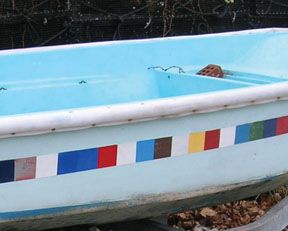
Practical Sailor readers who have been with us a few years may remember a topside paint test first reported in the February 2002 issue. We published an update in the January 2004 issue (we actually called it a finale back then, but thought one last look would offer some beneficial information). This is our final look at these paints, really. Since the test started, several new topside paint formulas have been introduced and we will begin testing these soon.
The idea was to try out high-quality marine paints that could be applied by the owner with a brush, so as to avoid the high cost of having a boatyard do a fabulous-looking but expensive job with Awlgrip, or one of its competitors, which need to be sprayed on in a controlled environment by really skilled professionals. The question was, could an owner do a good-looking job that would last for a reasonably long time for a lot less money?
In all, 39 paints were applied to the boat in swatch “bracelets” along each side of a 13-foot Boston Whaler. They included one- and two-part polyurethanes, alkyds, a water-soluble acrylic, fish-oil-based paints, and the propriety Awlgrip as a sort of control. Identical bracelets were painted, 1-39 (with a few repeats to even things out), from the bow aft on one side and from the transom forward on the other. (In general, the port-side paints fared worse, since they bore the brunt of fendering, docking, and dings.) All were applied carefully, by brush, in one coat only. The single coat allowed us to make some observations about ease of application, paint viscosity and thickness of coverage, and initial gloss. It also accelerated the deterioration of the paints, so that we could draw some conclusions in two years instead of four or more. As we said in 2004, the one-coat test couldn’t help but favor coatings that “went on thicker,” at least initially, but as time went on truer properties were revealed.
Two answers emerged. First, it’s hard to beat Awlgrip as the best answer to a faded gelcoat. Although it went on thinner and more transparent than most of the rest, after two years it looked just about as hard and glossy as it did an hour after it dried. And it looks about the same to this day. Second, while you may not beat Awlgrip, you can at least give it a run for the money. It is possible to get good results from off-the-shelf paints, even excellent results if you’re willing (and capable enough) to work with two-part polyurethanes. Although we tested some non-marine coatings, e.g. Pittsburgh’s Pitt-Tech, Royal alkyd from Ace Hardware, and Rust-Oleum, we found that the best paints came from companies with long track records in the marine paint trade.
Review of Results
To quote from our last report: “1. If you want your hull white and you prefer an easy-to-use one-part paint, buy Interlux’s Toplac. 2. If you want a white hull and are willing to do the work needed with a longer-lasting, two-part urethane, use Interlux’s Interthane. [Interlux has since replaced Interthane Plus with a similar paint it calls Perfection.] 3. If you want a blue hull and prefer the easier one-part urethane, the choice is Epifanes’ Mono-Urethane. 4. If you want a blue hull with a two-part paint, Epifanes’ Poly-Urethane is preferred. 5. If you want to do your hull red with a one-part paint, don’t. Use Epifanes’ two-part Poly-Urethane.”

In the chart of 2004, six of the 39 paints received Excellent overall ratings, and 10, including Awlgrip, received Good overall ratings. We thought it might be instructive to make one final tour of the paints on the boat, note any that still looked a cut above the rest, and put final comments alongside the 16 paints that did well last time.
Three people did the final look-see. None knew which paints were which, or what their previous ratings had been. Their comments are in the chart on the opposite page.
Conclusions
Your pick will depend upon color. For a one-part white, go with Interlux Toplac. For a two-part white, we could assume Interlux’s new Perfection is at least as good as the winner Interthane Plus, but can’t vouch for it. For red, only a two-part paint will do. Use Epifanes Poly-Urethane.
The choice of blue, however, has grown tricky. Among the two-parters, all three of our inspectors this time thought the Interlux Interthane Plus looked best—slightly better than the Epifanes blue. And this paint was rated “Good” last time.
Also performing well in the home stretch was Andek’s Polagard AG, an “aliphatic urethane” coating. It’s not meant to be a pleasure-boat paint, though—more of an industrial coating that can be used on “brick, stucco, concrete, structural steel, industrial equipment and other surfaces.” The AG actually stands for anti-graffiti. Since it’s normally a clear coating, and its colors are “custom,” and since it’s a bit off the beaten path and not much cheaper than pleasure-boat paints, we’d suggest sticking with Interlux or Epifanes. If you’re painting a freighter, that’s another matter.
Also With This Article
“Value Guide: Topside Paint Finalists”
Contacts
• Andek Corp., 856/786-6900, www.andek.com
• Epifanes North America, 800/269-0961, www.epifanes.com
• Interlux, 800/468-7589, www.yachtpaint.com
• Rust-Oleum, 800/553-8444, www.rustoleum.com
• Pettit & Kop-Coat, 800/221-4466, www.kop-coat.com
• U.S. Paint, 314/621-0525, www.uspaint.com
• West Marine, 800/262-8464, www.westmarine.com





































